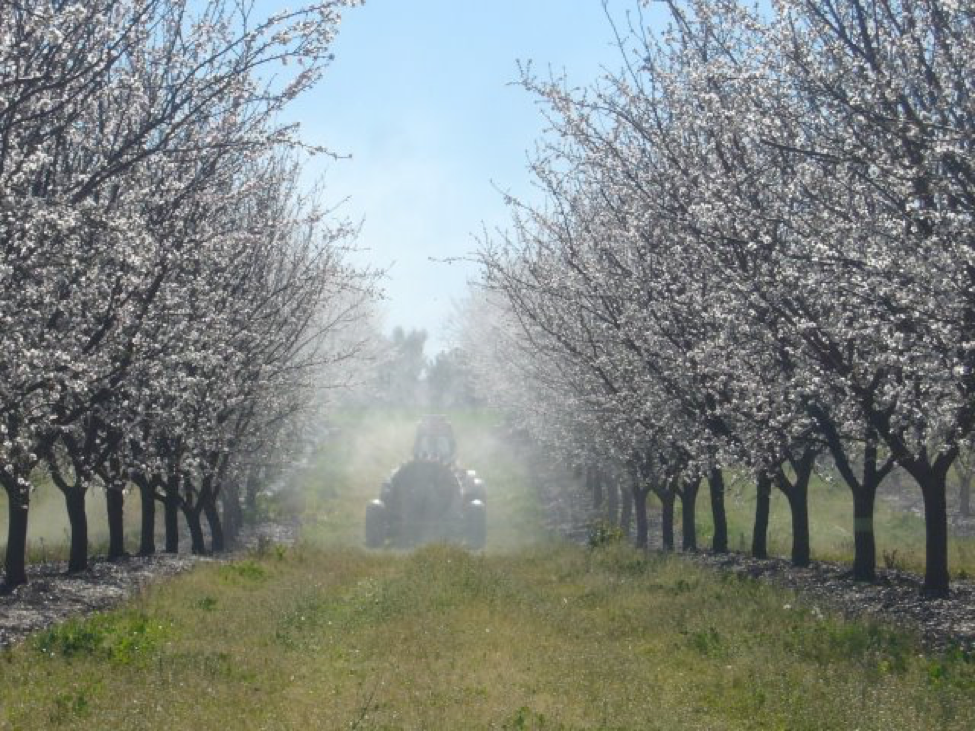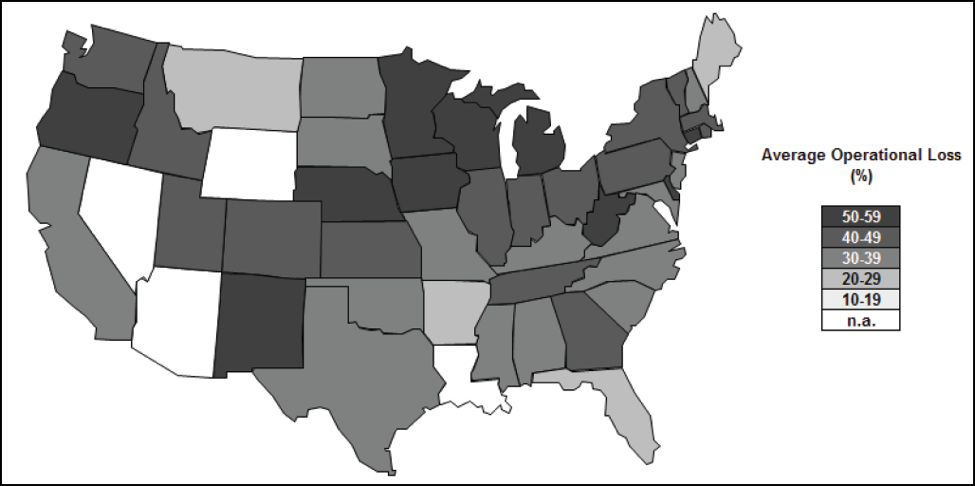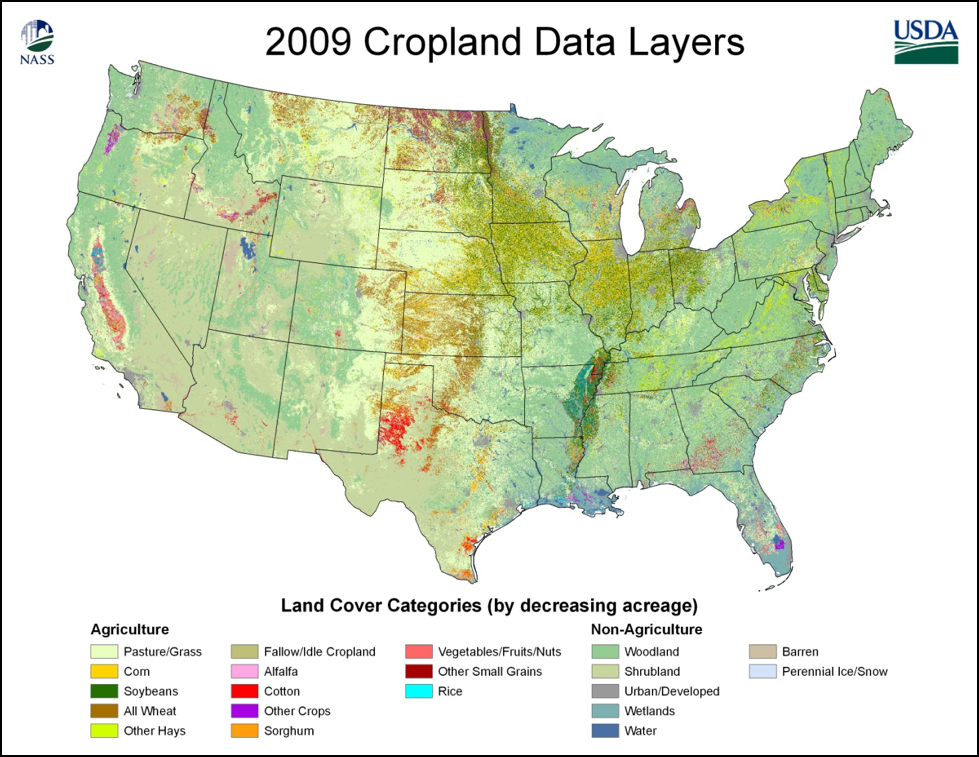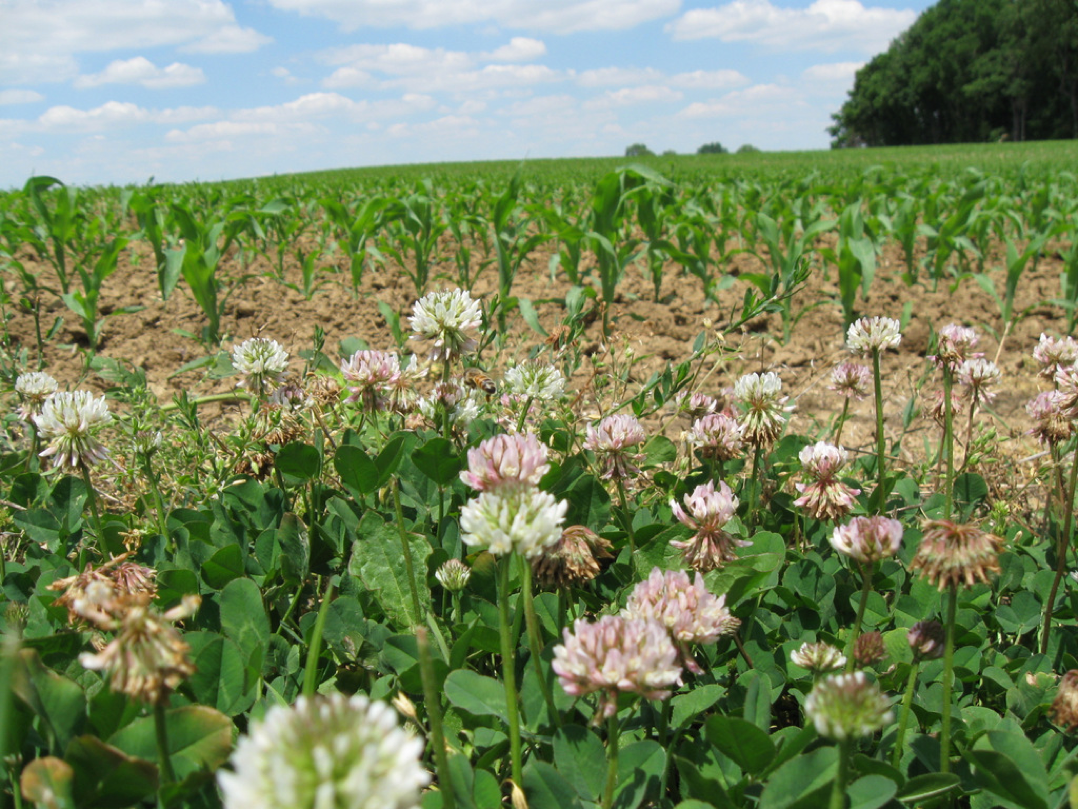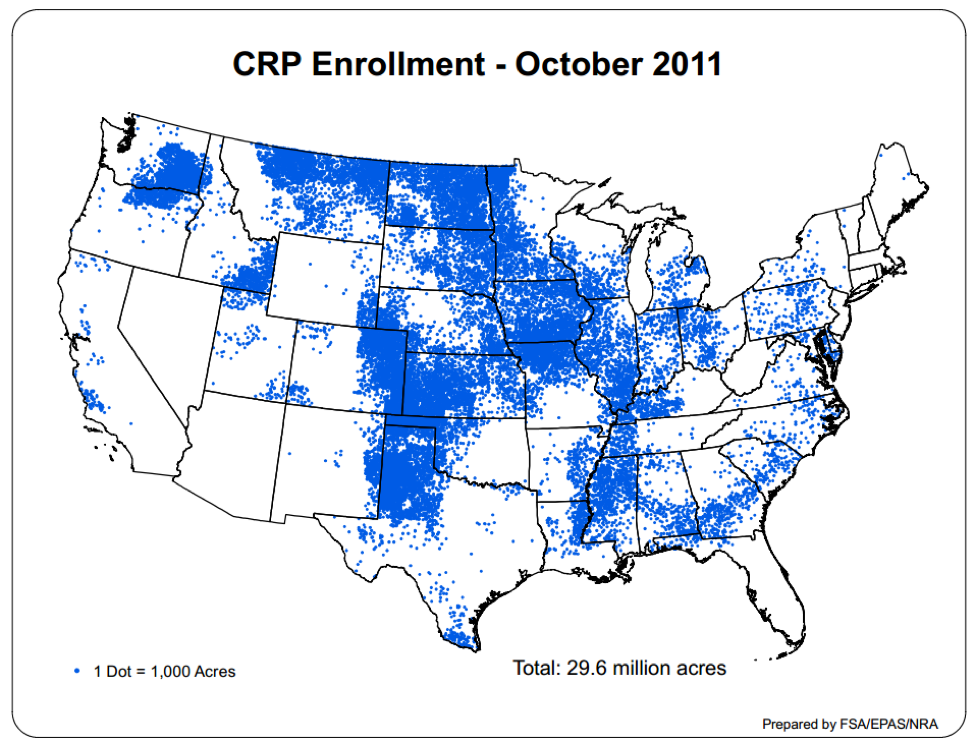Sick Bees – Part 18D: Colony Collapse Revisited – Agricultural Exposure
A Pesticide-Free Control Group
Sick Bees Part 18D: Colony Collapse Revisited
Agricultural Exposure
Randy Oliver
ScientificBeekeeping.com
Originally published in ABJ November 2012
“It’s what you know for sure that keeps you from learning.”
And I’m all about learning. I’d like to make it perfectly clear that I do not consider myself to be the final arbiter on any matter! In investigating many of these controversial subjects, my brain feels like a GPS unit, repeatedly saying, “Recalculating” and sometimes even “Turn around when possible.” This is why I take care to hold no positions, and appreciate being intelligently challenged on any point. If something comes to my attention that makes me rethink or correct anything I’ve written, I am more than happy to rebut myself on these pages.
Updates
Geomagnetic Flux
In my last article I dismissed geomagnetic flux as the cause of CCD, but also said that I was corresponding with proponent Dr. Tom Ferrari. A point that he recently made is that the timing of a flux event is critical—it must occur during, or immediately before flight hours. Although I still have a healthy skepticism about solar flares causing colony collapse, I am keeping an open mind that they may indeed affect bee homing ability, and could plausibly contribute to forager loss.
Driftwatch
In a recent article, I put in a good word for Purdue’s Driftwatch program [1], based upon the positive feedback that I had gotten from some beekeepers. However, I wish to thank beekeeper Jeff Anderson for bringing to my attention legitimate concerns about its uncritical promotion by state agencies.
First, some background on pesticide regulation. Pesticides are registered and labeled at the federal level by the EPA. States must follow those labels–they may impose further restrictions, but not fewer. In general, the state has primary authority for monitoring pesticide applicators to ensure that they comply with label restrictions, and is charged with the responsibility to take enforcement action in the case of violations (as in those resulting in bee kills). The EPA refers to the states as “primacy partners”; each of which may use a “state lead agency” (such as its department of pesticide regulation, agriculture, or environment to enforce the law [2].
A problem may occur when a state writes pesticide use guidelines for the protection of honey bees (and other pollinators). Pesticide applicators may put pressure on the local primacy partner to shift the responsibility of pollinator protection from the EPA and the applicator onto the shoulders of the beekeepers. If guidelines are written to suggest that beekeepers should register their apiary locations, and that applicators about to spray should then notify those beekeepers, the applicators may get the misimpression that such notification absolves them from their responsibility to carefully adhere to label restrictions, especially if there is any wording about the beekeeper moving or covering his hives. Commercial beekeepers strongly object to any suggestion that they be forced to “duck and cover”! And, a beekeeper may be adverse about putting his prime locations into a public database, which might result in some unscrupulous beekeeper moving in right on top of him!
In many places, conscientious applicators do indeed work constructively with beekeepers, and I’ve had them give me courtesy calls to discuss potential spray issues. As much as I appreciate that sort of cooperation, a large commercial beekeeper simply has too many locations, and not enough time to negotiate with every applicator who might be spraying within flight range of every one of his yards. It’s not the beekeeper’s job to be a pesticide expert–that’s the responsibility of the applicator!
The fact is that the EPA label restrictions are designed to protect pollinators, and if the restrictions are carefully followed, the beekeeper theoretically should need not ride herd on every pesticide applicator (Fig.1).
Figure 1. A grower spraying fungicide onto almond trees, and the understory weeds, each in full bloom. This sort of application is permitted by the label, and generally has only minor impact upon bees. However, EPA is closely following recent research on adverse effects of both fungicides and their adjuvants upon colony health.
Practical application: voluntary programs in which beekeepers may register their apiary locations to be notified by applicators can be of benefit (it works for me in my county), and a beekeeper may well wish to negotiate with an applicator about to make a lawful application. But beekeepers must be careful about allowing any “hot button” words involving the moving or covering of hives to be institutionalized in state guidelines, lest applicators get the misimpression that they can then ignore restrictions such as “Do not use on flowering crops or weeds” if they have notified the beekeeper, or that it is then the beekeeper’s responsibility to protect his hives from pesticide misapplication.
Back to the Suspects for CCD
Ag Exposure
Biological plausibility: plausible due to nutritional or pesticide issues.
Honey bees and farming have one major aspect in common—they both prosper on fertile, moist land. Prime bee forage land and prime agricultural land are one and the same. As it is, much of the world’s best acreage for bee forage has been converted to intensive agriculture, often dedicated to the cultivation of a single species of plant.
I’ve had beekeeper after beekeeper tell me how colonies summered on agricultural cropland often go downhill, or don’t make it through the winter. These anecdotal reports are supported by data from at least two studies:
- I mentioned a couple of months ago Dr. Erickson’s demonstration that colonies exposed to permethrin-sprayed corn died during the following winter.
- The Coordinated Action Project’s data for 2009-2012 [3] found that the proportion of land in intensive agriculture within 2 miles of the apiaries correlated with colony mortality. Although pesticides were obvious suspects, the study surprisingly did not find any particular correlations between pesticide levels in trapped pollen and amount of ag exposure, nor any correlations between pesticide exposure and colony mortality!
Curious as to whether recent colony losses (Fig. 2) correlate with the degree of exposure to commercial agriculture (Fig. 3), I checked the National Agricultural Statistics to find which states had the greatest percentages of their land areas in various crops.
Figure 2. Recent colony mortality rates for surveyed states. Compare the apparent correlation between those areas with high loss rates (dark states) with the types of cropland in the following map. Copyright the International Bee Research Association. Reproduced from [[i]] the Journal of Apicultural Research (2011) Issue 50(1): 1-10 by the permission of the Editors.
[[i]] vanEngelsdorp, D, et al (2011) A survey of managed honey bee colony losses in the USA, fall 2009 to winter 2010. Journal of Apicultural Research 50(1): 1-10.
Figure 3. The scope of the impact of farming practices is staggering–roughly 2/3rds of the land area in the entire states of Iowa and Illinois, and half the footage of Indiana and North Dakota, are planted to principal crops (a small amount is pasture). Source http://www.nass.usda.gov/research/Cropland/cdl09_l.jpg
It’s hard to compare the two maps above directly, since beekeepers move hives, and the colony mortality data is very crude by comparison (only to the state level) to the cropland map. However, one can’t help but see that colony mortality appears to be higher in corn, soy, and cotton areas.
As an aside, in researching this subject, I found that even more detailed interactive maps are available from the NASS (Fig. 4):
Figure 4. I created the above map to scout for alfalfa locations (in pink) in a small area of Nevada. The detail of these maps is amazing! Check it out at http://nassgeodata.gmu.edu/CropScape/.
Nutrition
The first thing about agricultural land and bees that generally comes to mind is the impact of pesticides, which I will return to later in this series. However, one must not ignore another important effect of crop monoculture—its impact upon bee nutrition:
“One impact of large-scale agriculture with extended expanses of a single cultivated crop species to honey bees is the availability of pollen, which is the only source of proteins and lipids in the bee diet and thus crucial for their survival and development. Agricultural trends toward larger monoculture farming systems can place pollinating honey bees in situations where they have a restricted choice of dietary pollen” [5].
So what is wrong with a “restricted choice” of pollen? Some “monolectic” species of solitary bees are specialized to feed solely on a single type of pollen (mono = single; lect = to gather). Honey bees, on the other hand, need to collect pollen throughout the season, so must by necessity be “polyletic” since no single plant species blooms for that long. Some pollens (almond, mustards, apples, red gum, etc.) are plentiful and nutritionally complete, but a number (corn, sunflower, blueberry, citrus, pumpkin) are not. If you’ve ever trapped pollen, you’ve noticed that pollen foragers bring home a medley of pollen types, thus increasing their chance of obtaining all necessary nutrients.
In agricultural areas, despite there being vast fields of single species of plants in bloom, bees still go out of their way to collect a diversity of pollens. Dr. Jerry Bromenshenk (in prep) has surveyed pollen loads in agricultural areas for the past few years. In corn country during tassling, he found that on average, corn pollen still constituted less than 25 percent of pollen loads. This is not surprising if you think about it, since if the bees in those areas are producing honey, they sure aren’t getting it from corn, so must have located other forage! When I visited apiaries in the Midwest, I surveyed their surroundings from the ground and via Google satellite maps–it appears that bees are remarkably efficient in finding little patches of good forage scattered among vast seas of corn and soybeans!
Another aspect of commercial crops is that plant breeders select for yield per acre, not for plants that produce nectar or nutritious pollen. Beekeepers report vast differences in bee response to different cultivars of several crops.
Practical application: Colonies may go downhill on certain crops due to poor pollen nutrition; they then need better forage in order to recover. Recent research found that colonies subsisting solely on corn pollen rear less brood, and have shorter worker lifespans [6]. Such colonies cannot be expected to winter well.
However, so long as alternative forage is available, bees may fare well in agricultural areas, provided that they don’t take a hit from pesticides.
A Pesticide-Free Control Group
I will return in a subsequent article to the impact of pesticides, but for now let me say that the few studies that have looked at pesticide levels in beebread do not clinch the case for pesticides being the only problem for bees in ag areas [7].
My apiaries often serve as a “control group” with regard to pesticides, since I avoid (other than in almonds) areas in which pesticides are used. Yet I still experience, in some locations, poor buildup, late summer dwindling, and poor winter survival. A case in point is a pumpkin pollination contract that I had for several recent years in an area of Nevada surrounded by desert (Fig. 5).
Figure 5. I pollinated 40 acres of pumpkins grown in this irrigated oasis in the middle of the desert. The only other “green” is a sod farm (most of the rectangular checks) and some center pivot alfalfa. No pesticides were used in this valley, yet colonies still fared poorly. Imagery from Google maps, ©DigitalGlobe, GeoEye, USDA Farm Service Agency, TerraMetrics.
The only forage available was 40 weedy acres of pumpkins, quite a bit of irrigated alfalfa, and natural Rabbitbrush in fall. Pesticides were not used anywhere in the valley. I’d move strong colonies in each July, heavy with stores, treated for mites, and with a 3-lb chunk of pollen supplement. The poor bees experienced boom and bust situations (mostly bust). The colonies simply starved on the forage provided by the pumpkins and weeds between alfalfa blooms (typically two blooms), and I generally had to resort to emergency open drum feeding and pollen supplement to keep them alive. Depending upon how much alfalfa was under irrigation that year, they might be able to rally and fill the combs with honey, or not. Some years they would rebound somewhat when Rabbitbrush came into bloom, but generally not enough to build up for winter.
In the above example, my 40 colonies were the only ones on about two square miles of irrigated green cropland. But there is no way that they could have survived on their own. There simply wasn’t enough consistent mixed forage to support them.
Living at the Edge and on the Edge
Unlike in natural areas, in which pollen and nectar flows transition fairly gradually, on agricultural lands they can be cut off in a matter of hours (just watch how fast a modern swather takes down a field of alfalfa in full bloom—breaks your heart). A flow can suddenly end when fields are tilled, when flowering weeds are mowed or burned off with an herbicide, or when every plant in a crop finishes blooming all at the same time. The bees are then forced to forage at the edges of the fields (Fig. 6).
Such a sudden cessation of food intake can also quickly bring a colony to the edge of serious protein deficit (not to mention the lack of nectar). The nurse bees in such a stressed colony must immediately deal with all the protein-hungry brood and foragers, and the colony must shift to survival mode.
The more I study bees, the more it appears to me that colonies are often living right on the edge of disaster. As I pointed out with my growth rate graphs [8], normal colony growth requires phenomenal production of brood, with a complete turnover of the summer population about every 5 weeks. Colonies can go from boom to bust in a matter of days if nutritious pollen and nectar become unavailable. Colony immunocompetence falters and broodrearing is curtailed, setting up conditions for varroa, nosema, or viruses to explode.
Practical tip: Here at Samemistaketwiceagain Apiaries, we find that as with many management issues involving bees, being proactive is much more cost effective than being reactive—it’s easier to maintain colony momentum than to restart them after they’ve come to a halt! A little supplemental feeding during dearth can go a long way towards healthier colonies.
Figure 6. The bee in the center of this photo is foraging at the edge of a cornfield that is weed-free after being sprayed with Roundup. The clover on the margins, and whatever grows in the patches of woods, is the only forage between here and the horizon. Modern farming practices greatly reduce the amount and diversity of bee forage. Photo courtesy of beekeeper Larry Garret.
Now add the pesticide component
When the forager force suffers attrition due to pesticides—although perhaps not enough to cause piles of dead bees in front of the hives—this will both reduce incoming nectar and pollen, plus force younger bees to take the places of the poisoned foragers. A strong colony full of sealed brood may be able to rebound from one hit to the foragers, but not from repeated hits, or from a hit late in the season.
Or, pesticide residues in stored pollen or nectar might negatively affect brood survival, harm the nurse bees (due to their eating so much pollen), decrease resistance to parasites, or shorten winter bee longevity. This may be especially true with the cocktail of insecticides, fungicides, and surfactants sometimes found in beebread.
During dearths (and in fall), a colony that shuts down into survival mode due to lack of pollen can generally stick it out until it can rebound when another nectar and pollen flow starts. However, the beekeeper should be aware that when a colony cuts back its population, the relative rate of infestation by varroa can quickly skyrocket! And if a colony in such a condition is then exposed to what would normally be a minor hit by pesticides, the negative effects can be greatly exacerbated.
Practical application: if, due to lack of alternative flora, bees are forced to forage solely on agricultural crops, then they may be exposed to pesticide residues that they would normally avoid, or store larger proportions of nutritionally-incomplete pollens (such as from field corn). Extension apiculturists have long pointed out that feeding colonies pollen supplement may help to mitigate the above problems. This is especially true in late summer as colonies suffer from the triple whammy of normal downsizing, poor nutrition, and rapidly rising varroa infestation rates.
CRP lands
Beekeeper Zac Browning explains that large-scale commercial beekeepers are having a tough time finding safe places to park their hives during the summer: “We’re limited to the fringes of rural America, where we can stay away from pesticides, where we can find wildflowers.”
One of the most popular places to look for locations has been on Conservation Reserve Program lands, for which farmers are paid by the government to convert cropland to long-term vegetative cover for the benefit of the environment. These lands in the northern states are often planted to clover or legumes, thus providing excellent forage for pollinators. As a result, commercial migratory beekeepers flock there during summer (Fig. 7).
Figure 7. CRP lands often provide good bee forage. Over a third of commercial hives spend the summer in just three states—Montana and North and South Dakota [[i]]. Map from USDA [[ii]].
[[i]] http://usda01.library.cornell.edu/usda/current/Hone/Hone-03-30-2012.pdf
[[ii]] http://www.fsa.usda.gov/Internet/FSA_File/crpenrolloct11dot.pdf
But with the high prices currently being offered for agricultural commodities, farmers are converting bee-friendly CRP land to monoculture cropland, putting the hurt on beekeepers. I don’t expect this situation to improve.
Good news
Press release: August 29, 2012
Portland, Ore.— Last Friday Agriculture Secretary Tom Vilsack announced that the Xerces Society for Invertebrate Conservation, along with collaborating bee researchers, will receive a $997,815 USDA Natural Resource Conservation Service Conservation Innovation Grant to improve pollinator habitat on farms and ranches across the U.S.
Through this project the researchers and conservationists hope to answer questions such as how to best manage wildflower meadows on the edge of farms as long term pollinator habitat, how to control weeds in such pollinator meadows using organic techniques, and how to quantify the effectiveness of various types of flowers in supporting crop-pollinating wild bees and honey bees. Another part of the project will work with native plant nurseries to mass-produce wildflower seed for plants with high pollen and nectar value that are not currently available among the nursery industry.
OK, the above sounds pretty idealistic, but beekeepers can certainly encourage these sorts of efforts to increase pollinator habitat on agricultural lands. Europe has a leg up on us in this direction, and can serve as an example [11]. Many landowners are willing to manage their lands for the benefit of wildlife, including pollinators. There is currently great support for such efforts across the political spectrum; beekeepers should certainly get on board the bandwagon!
Ag Exposure and CCD Conclusion
Colonies in agricultural lands often do not fare as well as those in favorable natural settings. It is not yet clear how much of the problem is due to pesticides or other factors, but the lack of diverse nutritional sources is a prime suspect.
Small-scale beekeepers may have thriving hives in agricultural areas in which large-scale beekeepers report problems. This observation suggests that hobbyists may have better luck in finding good apiary locations, perhaps since they don’t need to unload truckloads of hives.
Agricultural exposure does not fulfill Koch’s postulates as being the cause of CCD, but may well be a contributory factor in colony mortality and collapse.
To be continued…dare I broach the subject of GMO’s?
Acknowledgements
As always, I am immensely indebted to my partner in research, Peter Loring Borst. I wish to thank the hardworking members of our national associations (the National Honey Bee Advisory Board and the AHPA/ABF/EPA beekeeper pollinator protection work group members) who are representing beekeepers’ interests in Washington and at the state level. Darren Cox, Jeff Anderson, Dave Mendes, Steven Coy, and Rick Smith have been especially generous with their time in explaining the politics to me.
References
[1] http://www.driftwatch.org/
[2] http://www.epa.gov/opp00001/enforcement/monitoring.htm
[3] Drummund, F, et al (2012) The First Two Years of the Stationary Hive Project: Abiotic Site Effects. http://www.extension.org/pages/63773/the-first-two-years-of-the-stationary-hive-project:-abiotic-site-effects
[4] vanEngelsdorp, D, et al (2011) A survey of managed honey bee colony losses in the USA, fall 2009 to winter 2010. Journal of Apicultural Research 50(1): 1-10.
[5] Chauzat, M-P, et al (2009) Influence of pesticide residues on honey bee (Hymenoptera: Apidae) colony health in France. Environ. Entomol. 38(3): 514-523.
[6] Höcherl, N, et al (2012) Evaluation of the nutritive value of maize for honey bees. Journal of Insect Physiology 58(2): 278–285.
[7] Thompson, HM (2012) Interaction between pesticides and other factors in effects on bees. http://www.efsa.europa.eu/en/supporting/doc/340e.pdf
[8] https://scientificbeekeeping.com/sick-bees-part-17-nosema-the-smoldering-epidemic/
[9] http://usda01.library.cornell.edu/usda/current/Hone/Hone-03-30-2012.pdf
[10] http://www.fsa.usda.gov/Internet/FSA_File/crpenrolloct11dot.pdf
[11] Wratten, SD, et al (2012) Pollinator habitat enhancement: Benefits to other ecosystem services. Agriculture, Ecosystems & Environment 159: 112–122. Good bibliography of research papers on the subject.




